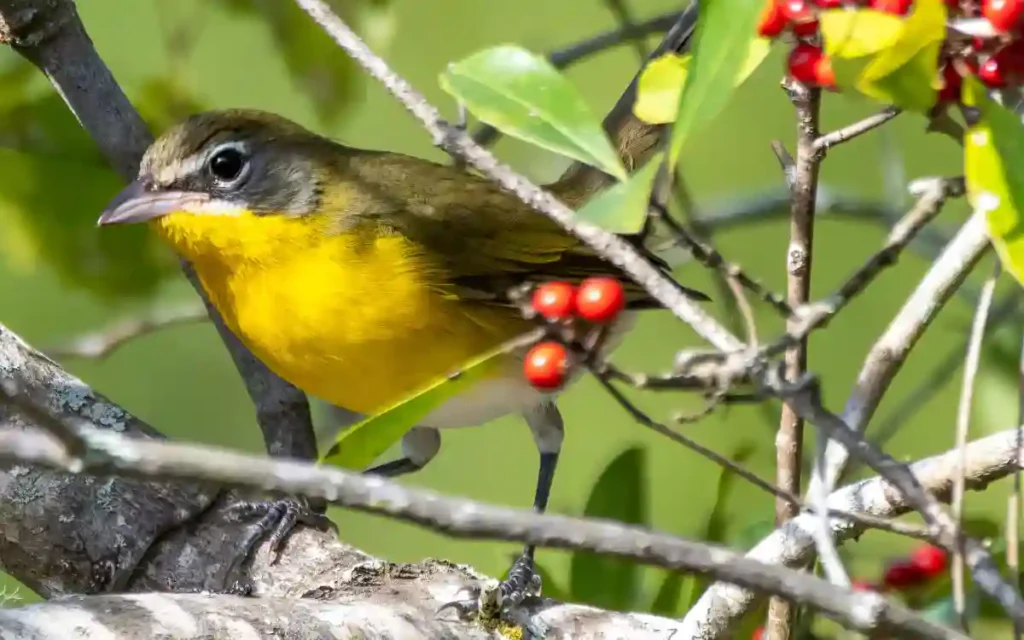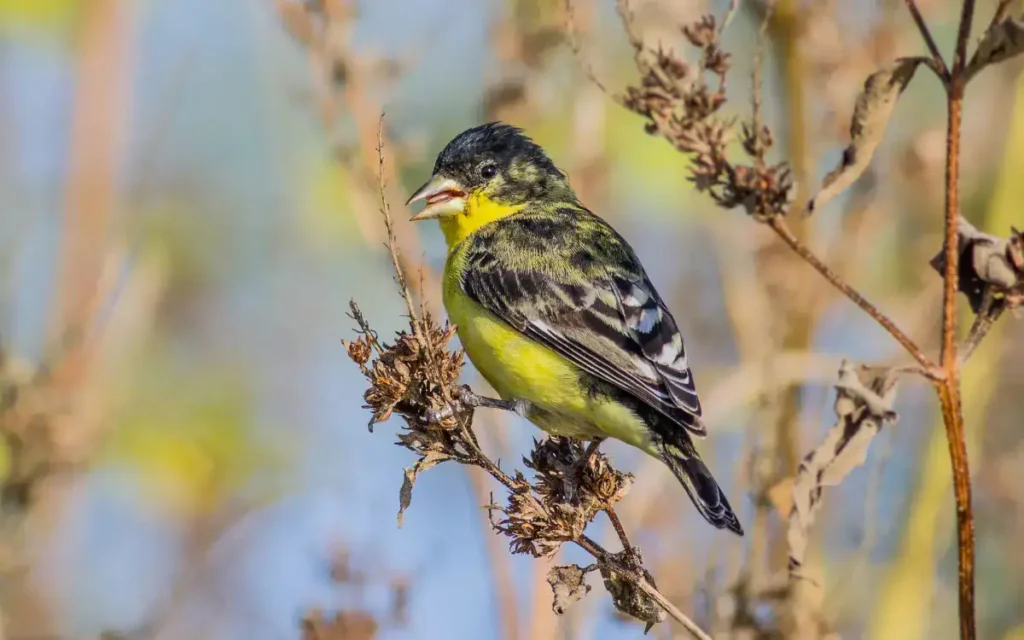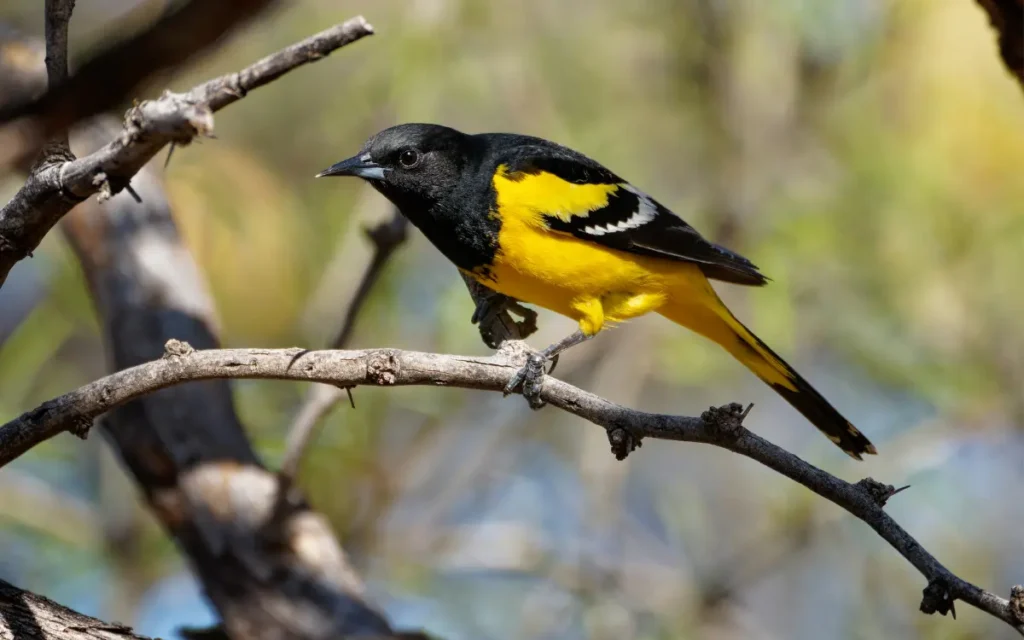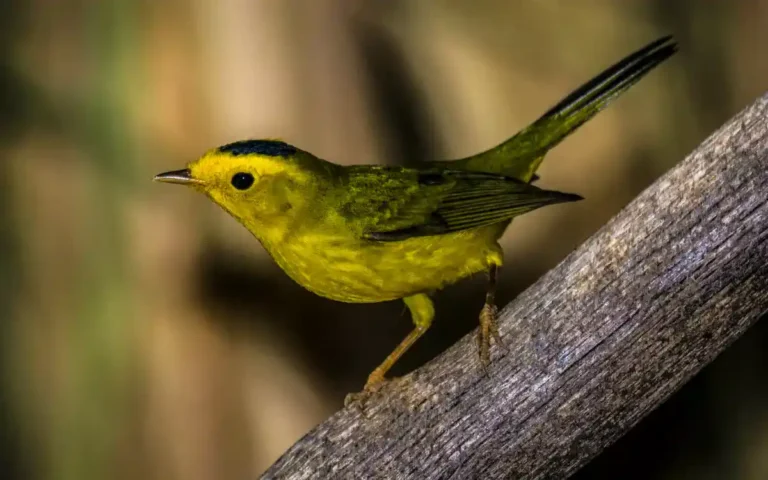18 Famous Yellow Birds in Arizona

Yellow birds in Arizona are amazing to watch! Learn about these colourful birds, like the bright Yellow Warbler and the small Verdin, and discover how they live in the sunny deserts and forests of Arizona.
List of 18 most Yellow birds in Arizona :
Arizona has many kinds of yellow birds. These birds are small and big. They look pretty and sing well. You can see birds like the Yellow Warbler, the Western Tanager, and the Western Meadowlark.
These birds are good for nature. They eat lots of bugs and help plants grow. They show us if their homes in nature are healthy. This is important for all plants and animals.
When you see these yellow birds, you learn about nature in Arizona. They make the outdoors beautiful with their colours and songs. We should take care of their homes so they stay safe and happy.
1.Yellow Warbler (Setophaga petechia)

The Yellow Warbler is a small, bright bird. It’s all yellow with a bit of green on its back. Males have stripes on their chests. These warblers fly to Arizona in spring to have babies. They build nests in bushes near water.
Yellow Warblers eat bugs like caterpillars and flies. This helps keep too many bugs from being in one place. In fall, they fly south again. Watching these warblers is fun because they are easy to see and hear.
- Length: 4.7-5.1 inches (12-13 cm)
- Weight: 0.3-0.4 ounces (9-11 g)
- Wingspan: 6.3-7.9 inches (16-20 cm)
2.Common Yellowthroat (Geothlypis trichas):

The Common Yellowthroat is a small bird with a special look. Males have a black mask on their faces. They live in Arizona’s marshy areas, where they make their nests close to the ground in thick bushes.
These birds like to eat small insects like flies and spiders. This helps control the number of bugs around. The Common Yellowthroat travels to warmer places in winter and comes back to Arizona to breed in spring. They are fun to spot because of their bright colours and masks.
- Length: 4.3-5.1 inches (11-13 cm)
- Weight:0.3-0.3 ounces (9-10 g)
- Wingspan: 5.9-7.5 inches (15-19 cm)
3.Western Tanager (Piranga ludoviciana):

The Western Tanager is a bird with bright colours. It has a red head, yellow body, and dark wings. They come to Arizona in the spring and summer. Here, they build nests in trees to lay eggs.
These birds eat insects and fruit like berries. They catch bugs in the air or on trees. In the fall, they go south for winter. The Western Tanager is easy to spot because of its red and yellow colours. They are pretty and fun to watch.
- Length: 6.3-7.5 inches (16-19 cm)
- Weight:0.8-1.3 ounces (24-36 g)
- Wingspan: 11-11.5 inches (28-29 cm)
4.Townsend’s Warbler (Setophaga townsendi):

The Townsend’s Warbler is a small bird with eye-catching colours. It has a yellow face, black and yellow body, and dark wings. These warblers visit Arizona during their spring and fall travels.
They like to eat bugs and insects, which they find in trees and bushes. This helps keep the bug numbers just right in nature.
The Townsend’s Warbler doesn’t stay in Arizona to have babies; they just visit while moving to different places. Their colourful look makes them a special sight for people who love birds.
- Length: 5.5-6.7 inches (14-17 cm)
- Weight: 0.5-0.7 ounces (14-19 g)
- Wingspan: 8.7-9.8 inches (22-25 cm)
5.Bullock’s Oriole (Icterus bullockii) :

The Bullock’s Oriole is a colourful bird. It has a bright orange and black body. They come to Arizona in spring to make nests in tall trees.
These birds like to eat insects and fruit, like berries. They are good at catching bugs in trees. In the winter, they go to warmer places.
The Bullock’s Oriole is special because of its bright colours. People enjoy watching them in the trees. They are beautiful and interesting to see.
- Length: .7-7.5 inches (17-19 cm)
- Weight: 1.0-1.5 ounces (29-43 g)
- Wingspan: 12.2 inches (31 cm)
Related article:
6.Black-throated Green Warbler (Setophaga virens):

The Black-throated Green Warbler is a little bird with a black throat and a bright yellow face. It has green on its back. They sometimes come to Arizona on their way to other places.
These warblers eat bugs like spiders and caterpillars. This helps keep too many bugs away. The Black-throated Green Warbler is known for moving around a lot. It’s exciting to see one because they are not common. They are pretty with their black and yellow colours.
- Length: 4.3-4.7 inches (11-12 cm)
- Weight:0.3-0.4 ounces (7-11 g)
- Wingspan: 6.7-7.9 inches (17-20 cm)
7.Yellow-breasted Chat (Icteria virens):

The Yellow-breasted Chat is a unique bird with a yellow chest and an olive-green back. They are bigger than most warblers. You can find them in Arizona in spring and summer.
They like to eat small insects and berries.This makes them important for keeping the bug numbers right. The Yellow-breasted Chat builds nests in thick bushes. They are known for being a bit secretive. Spotting one is fun because they are not seen very often. Their bright yellow chest makes them stand out.
- Length: 7.1 inches (18 cm)
- Weight: 0.8-1.1 ounces (23-31 g)
- Wingspan: 9.8 inches (25 cm)
8.Cape May Warbler (Setophaga tigrina) :

The Cape May Warbler is a small bird with a yellow neck and chest, and dark stripes. It has a patch of white on its wings. These warblers visit Arizona sometimes when they move to different places.
They eat mostly insects, like caterpillars and flies. This helps them stay healthy. The Cape May Warbler doesn’t stay long in one place.
They like to travel a lot. These birds are not seen much, so it’s exciting when you spot one. They are pretty and interesting.
- Length: 4.7-5.1 inches (12-13 cm)
- Weight:0.4-0.5 ounces (10.2-15.2 g)
- Wingspan: 7.9-8.7 inches (20-22 cm)
9.Lesser Goldfinch (Spinus psaltria) :

The Lesser Goldfinch is a tiny bird with a bright yellow underbelly and dark wings. They are often seen in Arizona all year.
These small birds eat seeds and insects, which makes them important for the balance of nature. The Lesser Goldfinch likes to stay in places with trees and open fields.
They are not hard to spot because of their bright colours. These goldfinches are fun to watch, especially when they gather in groups. Their cheerful yellow colour makes them a delightful sight.
- Length: 3.5-4.3 inches (9-11 cm)
- Weight: 0.3-0.4 ounces (8-11.5 g)
- Wingspan: 5.9-7.9 inches (15-20 cm)
10.Evening Grosbeak (Hesperiphona vespertina):

The Evening Grosbeak is a big bird with yellow and black feathers. They are found in Arizona, mainly in the eastern part.
They eat seeds and fruits, which is good for the plants. The Evening Grosbeak likes to live in forests. Seeing one is special because they are not very common.
They stand out with their big size and bright colours. Watching these grosbeaks is interesting, especially when they are eating seeds in trees. They are beautiful birds with their unique yellow feathers.
- Length: 6.3-7.1 inches (16-18 cm)
- Weight: 1.9-2.6 ounces (53-74 g)
- Wingspan: 11.8-14.2 inches (30-36 cm)
11.Western Meadowlark (Sturnella neglecta):

The Western Meadowlark is a bird with a bright yellow chest and a black V-shaped mark on its neck. They live in Arizona most of the year.
They eat insects and seeds, which helps plants grow and keeps the bug numbers right. The Western Meadowlark likes to stay in open fields and meadows.
They are known for their pretty singing. It’s fun to watch them because they are easy to spot and hear. Their yellow chest makes them really pretty in the sunlight.
- Length: 6.3–10.2 inches (16–26 cm)
- Weight: 3.1–4.1 ounces (88–116 g)
- Wingspan: 16.1 inches (41 cm)
12.MacGillivray’s Warbler (Geothlypis tolmiei)

The MacGillivray’s Warbler is a small bird with a grey head and olive-green back. Its throat and chest are yellow.
These warblers are rarely seen in Arizona during their migration.
They eat insects like flies and beetles, which helps control the number of these bugs.
The MacGillivray’s Warbler travels a lot and doesn’t stay in one place for too long. Spotting one of these warblers is special because they are not often seen. Their mix of grey and yellow makes them a neat bird to see.
- Length: 3.9–5.9 inches (9.9–15.0 cm)
- Weight: 0.3–0.5 ounces (8.5–14.2 g)
- Wingspan: 7.5 inches (19 cm)
13.American Goldfinch (Spinus tristis) :

The American Goldfinch is a small bird with bright yellow feathers. It’s seen in Arizona, especially in the summer.
They eat seeds, like those from sunflowers, which helps spread plant seeds around. The American Goldfinch likes areas with lots of flowers and trees.
They are easy to spot because of their yellow colour. Watching these birds is fun, especially when they are in groups. Their cheerful colour and singing make them a joy to see. They are pretty birds with their yellow and black feathers.
- Length: 4.3-5.1 in (11-13 cm)
- Weight: 0.4-0.7 oz (11-20 g)
- Wingspan: 7.5-8.7 in (19-22 cm)
14.Scott’s Oriole (Icterus parisorum) :

The Scott’s Oriole is a striking bird with a black head and back and bright yellow belly. They are often seen in Arizona during the breeding season.
These orioles eat insects and nectar, which helps control bug populations and pollinate flowers. The Scott’s Oriole likes to build nests in tall trees, especially in palm trees.
Spotting one is exciting because of their bold colours. They are easy to identify with their black and yellow feathers. Watching them can be really fun, especially when they sing from the treetops.
- Length: 9.1 in (23 cm)
- Weight: 1.1-1.4 oz (32-41 g)
- Wingspan: 12.6 in (32 cm)
Related article: 15 Red Birds Live in Arizona
15.Verdin (Auriparus flaviceps)

The Verdin is a small bird with a grey body and a bright yellow head. They live in Arizona all year.Verdins eat insects and small fruits, which helps keep nature balanced. They build unique nests in thorny bushes.
The Verdin is easy to spot because of its yellow head. They are often seen alone, moving quickly through bushes. Seeing a Verdin is special because they are tiny and quick. They are neat to watch, especially when they hop around in bushes.
- Length: 4.5 inches (11 cm)
- Weight: 0.3-0.4 ounces (8-11 g)
- Wingspan: 6-7 inches (15-18 cm)
16.Hooded Warbler (Setophaga citrina) :

The Hooded Warbler is a small bird with a yellow face and chest, and a black hood. They visit Arizona, but are not very common.
These warblers eat insects, which helps keep the bug numbers in check. The Hooded Warbler likes to live in forests with thick bushes.
They are a bit hard to find because they stay hidden in leaves. But if you see one, it’s exciting because of their pretty colours. They are special with their bright yellow and black pattern.
- Length: 5.1 in (13 cm)
- Weight:0.3-0.4 oz (9-12 g)
- Wingspan: 6.9 in (17.5 cm)
17.Couch’s Kingbird (Tyrannus couchii):

The Couch’s Kingbird is a bird with a grey head and olive back. They have a bright yellow belly. This bird is rare in Arizona.
They eat insects, which they catch in the air. This is good for keeping too many bugs away. The Couch’s Kingbird is known for its loud calls.
They like to stay in open woods and near water. Seeing one is rare and exciting because they are not often in Arizona. They stand out with their loud calls and bright yellow belly.
- Length: 7 inches (17.8 cm)
- Weight: 1.1 – 1.5 ounces (30 – 42 gm)
- Wingspan: 12 -14 inches (30 to 36 cm)
18. Hooded Oriole (Icterus cucullatus) :

The Hooded Oriole is a bird with bright orange and black colours. They come to Arizona in the breeding season.They eat insects and nectar, which is good for plants. The Hooded Oriole builds hanging nests in palm trees.
Spotting one is fun because of their colourful look. They are easy to see because of their bright colours. Watching them can be exciting, especially when they are feeding on flowers. They are beautiful birds with their orange and black feathers.
- Length: 7.1-7.9 in (18-20 cm)
- Weight: 0.8 oz (24 gm)
- Wingspan: 9.1-11.0 in (23-28 cm)
Birdwatching Tips for Observing Yellow Birds in Arizona
To see yellow birds in Arizona, try these tips. Go early in the morning or late in the afternoon, as birds are most active then. Spring and summer are the best seasons. Visit places with trees and water, like parks and forests.
Bring binoculars to see birds up close. Be quiet and move slowly so you don’t scare the birds away. Look for bright yellow colours in the trees. Listen for bird songs, as this can help you find them. Remember to be patient, as finding birds can take time.
Also read about – 6 species of Arizona falcons
Environmental Protection Measures:
Many yellow birds in Arizona are doing okay, but some need help. People are working to keep their homes safe. This means protecting places like forests and wetlands where these birds live. It’s important not to harm these areas.
Some birds face problems because their homes are getting smaller or changing. People are building houses and roads were birds used to live.
Also, the weather is changing, which can be hard for birds. Groups are making new homes for birds and teaching people how to help.
Everyone can help by keeping places clean and safe for birds. We need to take care of nature so these beautiful birds can stay healthy, just like the ducks of Arizona.
FAQs :
Q: What are the little yellow birds in Arizona?
A: In Arizona, little yellow birds are often Lesser Goldfinches or Yellow Warblers. They are small and bright yellow.
Q: Which bird is yellow in color?
A: The American Goldfinch is yellow in colour. It’s a small bird with bright yellow feathers, especially in the summer.
Q: What is the small yellow bird in Phoenix?
A: In Phoenix, the small yellow bird you might see is often a Verdin. They have a grey body with a bright yellow head.
Q: What is the yellow bird of paradise Arizona?
A: The “Yellow Bird of Paradise” is not a bird, but a plant commonly found in Arizona. It has yellow flowers and is named for its resemblance to the bird of paradise.
Q: How can I attract yellow birds to my yard?
A: To attract yellow birds, use bird feeders with seeds like sunflower or thistle. Planting native flowers and shrubs can also help.
Conclusion :
Arizona’s yellow birds are beautiful and important. They bring colour and songs to the outdoors. We can enjoy them by watching carefully and keeping their homes safe. Remember, every bird is special in its own way. Let’s protect these wonderful creatures and their homes in Arizona.






